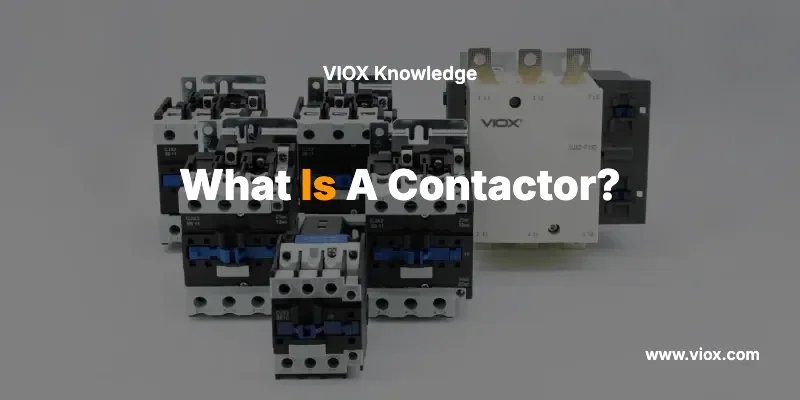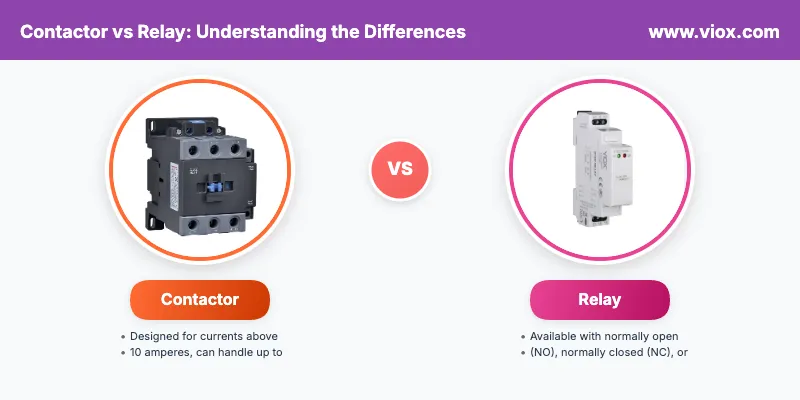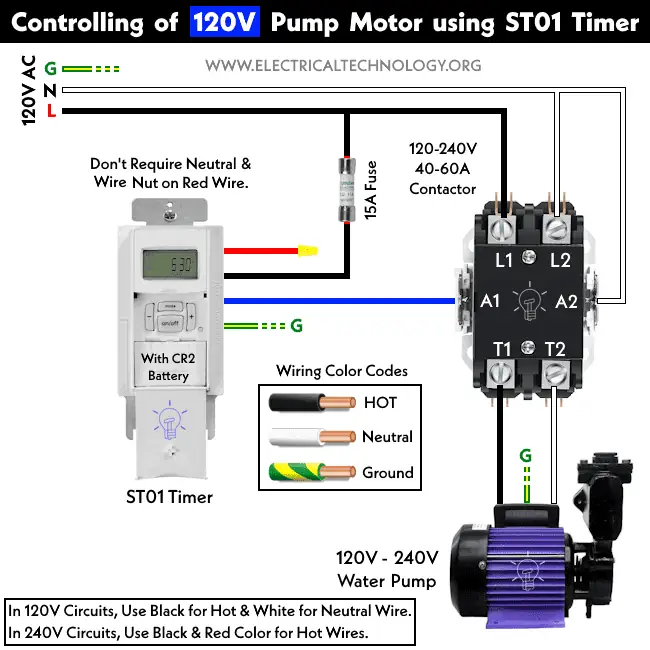مقدمة
الموصل الكهربائي هو جهاز تحويل متخصص مصمم للتحكم في الدوائر الكهربائية عالية القدرة بأمان وكفاءة. وعلى عكس المفاتيح القياسية، يستخدم الموصل مبادئ كهرومغناطيسية لفتح وإغلاق التوصيلات الكهربائية، مما يجعله مكونات أساسية في الأتمتة الصناعية، والتحكم في المحركات، والأنظمة الكهربائية التجارية.
يُعد فهم ماهية الموصل الكهربائي وكيفية عمله أمرًا بالغ الأهمية لأي شخص يعمل في الأنظمة الكهربائية، من المهندسين والفنيين إلى مديري المنشآت. يشرح هذا الدليل الشامل كل ما تحتاج لمعرفته حول الموصلات الكهربائية، وتطبيقاتها، وأسباب أهميتها في التركيبات الكهربائية الحديثة.
ما هو المقاول؟
A مقاول هو جهاز تبديل كهروميكانيكي يستخدم ملفًا كهرومغناطيسيًا للتحكم في فتح وإغلاق جهات الاتصال الكهربائية، مما يتيح التحكم الآمن في الدوائر عالية الطاقة. يعمل الجهاز كمفتاح يعمل بالكهرباء، مما يسمح لدوائر التحكم ذات الجهد المنخفض بإدارة الأحمال الكهربائية ذات الجهد العالي والتيار العالي بأمان.
الخصائص الرئيسية للمقاولات:
- التشغيل عن بعد:يمكن التحكم بها عن بعد باستخدام إشارات الجهد المنخفض
- سعة تيار عالية:مصممة للتعامل مع الأحمال الكهربائية الكبيرة (عادةً ما تكون أعلى من 10 أمبير)
- التبديل المتكرر:مصمم لآلاف دورات التشغيل والإيقاف دون تدهور
- عزل السلامة:يوفر الفصل الكهربائي بين دوائر التحكم والطاقة
- التشغيل الكهرومغناطيسي:يستخدم القوة المغناطيسية لتشغيل الاتصال بشكل موثوق
كيف يعمل المقاول؟
يعتمد مبدأ تشغيل الموصل على آليات الجذب الكهرومغناطيسي والعودة الزنبركية:
عملية خطوة بخطوة:
- التنشيط:عند تطبيق الجهد على ملف الموصل (عادةً 24 فولت، أو 120 فولت، أو 240 فولت)، فإنه ينشئ مجالًا مغناطيسيًا
- الجاذبية المغناطيسية:يجذب المجال المغناطيسي نواة حديدية متحركة (محرك) نحو النواة الكهرومغناطيسية الثابتة
- إغلاق الاتصال:تجبر حركة المحرك جهات الاتصال المتحركة على مواجهة جهات الاتصال الثابتة، مما يكمل الدائرة
- تدفق التيار:يمكن الآن للتيار الكهربائي أن يتدفق عبر جهات الاتصال الرئيسية لتشغيل الحمل المتصل
- إزالة الطاقة:عند إزالة طاقة الملف، ينهار المجال المغناطيسي
- عودة الربيع:تسحب قوة الزنبرك المحرك للخلف، مما يؤدي إلى فتح جهات الاتصال وقطع تدفق التيار
المكونات الكهرومغناطيسية:
ملف/مغناطيس كهربائي:قلب الموصل، الذي يخلق المجال المغناطيسي عند تنشيطه
المحرك:اللب الحديدي المتحرك الذي يستجيب للمجال المغناطيسي
جهات الاتصال:العناصر الموصلة التي تصنع أو تقطع الاتصال الكهربائي
الينابيع:توفير قوة العودة لفتح جهات الاتصال عند إزالة الطاقة من الملف
أنواع الملامسات
ملامسات التيار المتردد
تم تصميم موصلات التيار المتردد خصيصًا لتطبيقات التيار المتناوب وهي النوع الأكثر استخدامًا في الإعدادات التجارية والصناعية.
الميزات الرئيسية:
- بناء النواة الرقائقية:يستخدم صفائح الفولاذ السيليكوني لتقليل خسائر التيار الدوامي
- قمع القوس:يتضمن مزالق قوسية وتفجيرًا مغناطيسيًا لإطفاء الأقواس بسرعة
- القدرة على ثلاث مراحل:مصممة عادة للتحكم في دوائر المحرك ثلاثية الطور
- تصنيفات الجهد:متوفر من 120 فولت إلى 1000 فولت+
التطبيقات الشائعة:
- التحكم في المحركات الكهربائية (المضخات والمراوح والضواغط)
- تبديل نظام التدفئة والتهوية وتكييف الهواء
- أنظمة التحكم في الإضاءة
- أتمتة الآلات الصناعية
ملامسات التيار المستمر
تتعامل موصلات التيار المستمر مع أحمال التيار المستمر وتتميز بعناصر تصميم متخصصة لإدارة التحديات الفريدة المتمثلة في تحويل التيار المستمر.
الميزات الرئيسية:
- قلب فولاذي صلب:تستخدم مواد حديدية مغناطيسية صلبة حيث أن التيارات الدوامية لا تشكل مصدر قلق
- تعزيز قمع القوس:يتطلب طرق إخماد القوس أكثر قوة بسبب التيار المستمر
- انفجار مغناطيسي:غالبًا ما يتضمن ملفات تفجير مغناطيسية لتوجيه الأقواس بعيدًا عن جهات الاتصال
- فجوة اتصال أعلى:مسافات فصل أكبر لضمان إخماد القوس بشكل موثوق
التطبيقات الشائعة:
- أنظمة الطاقة الشمسية وبنوك البطاريات
- التحكم في محركات التيار المستمر (المصاعد والرافعات)
- أنظمة شحن المركبات الكهربائية
- تطبيقات السكك الحديدية والنقل
أنواع المقاولين المتخصصين
- الملامسات العكسية:تتميز بمجموعات اتصال مزدوجة لعكس اتجاه دوران المحرك بأمان
- مقاولات الإضاءة:مُحسَّن للأحمال المقاومة مع آليات الإغلاق لتحقيق كفاءة الطاقة
- موصلات المكثف:مصمم لتبديل مكثفات تصحيح معامل القدرة
- موصلات الفراغ:استخدم جهات اتصال محكمة الغلق في التطبيقات ذات الجهد المتوسط والعالي
الموصل مقابل المرحل: فهم الاختلافات
على الرغم من أن الملامسات والمرحلات تعمل على مبادئ كهرومغناطيسية مماثلة، إلا أنها تخدم أغراضًا مختلفة ولها خصائص مميزة:
سعة الحمولة
- المقاولين:مصمم للتيارات التي تزيد عن 10 أمبير، ويمكنه التعامل مع ما يصل إلى آلاف الأمبير
- المرحلات:مُصنَّف عادةً لتيارات تبلغ 10 أمبير أو أقل
تكوين جهة الاتصال
- المقاولين:استخدم في المقام الأول جهات اتصال مفتوحة عادةً (NO) تُغلق عند تنشيطها
- المرحلات:متوفر مع جهات اتصال مفتوحة عادةً (NO)، أو مغلقة عادةً (NC)، أو جهات اتصال تحويل
الحجم المادي والبناء
- المقاولين:بناء أكبر وأكثر قوة للتعامل مع الأحمال عالية الطاقة
- المرحلات:تصميم مضغوط مناسب لتطبيقات دائرة التحكم
إخماد القوس الكهربائي
- المقاولين:تتضمن آليات متطورة لقمع القوس الكهربائي للتبديل عالي التيار
- المرحلات: الحد الأدنى من قمع القوس الكهربائي لأنها تتعامل مع تيارات أقل
التطبيقات
- المقاولين:التحكم في المحركات، أنظمة الإضاءة، الأحمال الصناعية الثقيلة
- المرحلات: تبديل الإشارة، منطق التحكم، التحكم في الأجهزة منخفضة الطاقة
ميزات السلامة
- المقاولين:غالبًا ما تتضمن حماية من الحمل الزائد وجهات اتصال أمان إضافية
- المرحلات:وظيفة التبديل الأساسية بدون ميزات حماية إضافية
تطبيقات واستخدامات الموصلات
أنظمة التحكم في المحركات
الائتمان إلى التكنولوجيا الكهربائية
تعتبر الموصلات ضرورية في تطبيقات التحكم في المحرك، حيث توفر:
- بدء التشغيل والتوقف الآمن من المحركات الكهربائية
- الحماية من التحميل الزائد عند دمجها مع مرحلات الحمل الزائد الحراري
- التشغيل عن بعد من لوحات التحكم أو أنظمة التشغيل الآلي
- إمكانية التوقف في حالات الطوارئ للامتثال للسلامة
الأتمتة الصناعية
في التصنيع ومراقبة العمليات:
- التحكم في نظام الناقل
- تشغيل المضخة والضاغط
- معدات مناولة المواد
- أتمتة خطوط العمليات
أنظمة المباني التجارية
- التحكم في التدفئة والتهوية وتكييف الهواء:إدارة أنظمة التدفئة والتهوية وتكييف الهواء
- إدارة الإضاءة:التحكم في تركيبات الإضاءة الكبيرة في المباني المكتبية ومساحات البيع بالتجزئة
- توزيع الطاقة:لوحات التبديل الكهربائية ولوحات التوزيع
توليد الطاقة وتوزيعها
- أنظمة التحكم في المولدات
- تبديل بنك المكثفات لتصحيح معامل القدرة
- أتمتة المحطات الفرعية
- أنظمة الطاقة المتجددة (الطاقة الشمسية وطاقة الرياح)
مواصفات واختيار المقاولين
التصنيفات الكهربائية
- تصنيف الجهد:أقصى جهد يمكن للملامس التعامل معه بأمان
- التصنيف الحالي:أقصى سعة للتيار المستمر
- تصنيف قوة الحصان:سعة حمل المحرك عند جهد محدد
- فئة الاستخدام:يحدد نوع الحمل (AC-1 للمقاومات، AC-3 للمحركات)
مواصفات الملف
- جهد الملف: جهد التشغيل للملف الكهرومغناطيسي (24 فولت، 120 فولت، 240 فولت، إلخ.)
- نوع الملف:تشغيل التيار المتردد أو المستمر
- استهلاك الطاقة:الطاقة المطلوبة للحفاظ على تنشيط الملف
الخصائص الميكانيكية
- مواد الاتصال:سبائك الفضة، وأكسيد الفضة، أو غيرها من المواد المتخصصة
- عدد الأعمدة:تكوينات أحادية القطب، ثنائية القطب، ثلاثية الأقطاب، أو رباعية الأقطاب
- جهات الاتصال المساعدة:جهات اتصال إضافية لوظائف دائرة التحكم
- نوع التركيب: سكة DIN، أو التركيب على اللوحة، أو طرق التثبيت الأخرى
الاعتبارات البيئية
- نطاق درجة الحرارة: حدود درجة حرارة التشغيل
- تصنيف العلبة:الحماية من الغبار والرطوبة والمخاطر البيئية
- مقاومة الاهتزازات:القدرة على تحمل الضغوط الميكانيكية
- تصنيف الارتفاع:الأداء على ارتفاعات مختلفة
التركيب والأسلاك
توصيلات الملامس النموذجية
- محطات الخطوط (L1، L2، L3):الاتصال بمصدر الطاقة الوارد
- محطات التحميل (T1، T2، T3):التوصيل بالحمل الكهربائي (المحرك، الأضواء، وما إلى ذلك)
- محطات الملف (A1، A2):التوصيل بدائرة التحكم بالجهد
- جهات الاتصال المساعدة:تستخدم في دوائر الإشارة أو التشابك أو التغذية الراجعة
تكامل دائرة التحكم
يتم دمج الملامسات عادة في أنظمة التحكم مع:
- أزرار التشغيل/الإيقاف للتشغيل اليدوي
- مرحلات التحميل الزائد لحماية المحرك
- مخرجات PLC للتحكم الآلي
- مرحلات المؤقت للعمليات المتسلسلة
اعتبارات السلامة
- التأريض المناسب من جميع الأجزاء المعدنية
- حماية من قوس الوميض عند العمل على المعدات النشطة
- إجراءات القفل/التعليق أثناء الصيانة
- الموافقات الكافية للتشغيل والصيانة الآمنة
الصيانة واستكشاف الأعطال وإصلاحها
مهام الصيانة الدورية
- الفحص البصري:تحقق من وجود علامات ارتفاع درجة الحرارة أو التآكل أو التلف المادي
- فحص الاتصال:فحص جهات الاتصال بحثًا عن أي تآكل أو حرق أو تآكل مفرط
- اختبار الملف:التحقق من مقاومة الملف والعزل المناسبين
- التشغيل الميكانيكي:تأكد من حركة المحرك بسلاسة وحركة الزنبرك المناسبة
المشاكل الشائعة والحلول
- جهات الاتصال لا تغلق:تحقق من جهد الملف، أو العوائق الميكانيكية، أو الينابيع البالية
- جهات الاتصال الملحومة المغلقة: يشير عادةً إلى ظروف التيار الزائد أو قمع القوس غير الكافي
- عملية الثرثرة:قد يشير إلى انخفاض جهد الملف أو وجود مشكلات ميكانيكية
- السخونة الزائدة:قد يكون ذلك نتيجة لضعف التوصيلات أو التحميل الزائد أو التهوية غير الكافية
إرشادات الاستبدال
استبدل الموصلات عندما:
- تظهر جهات الاتصال تآكلًا أو تلفًا مفرطًا
- مقاومة الملف خارج مواصفات الشركة المصنعة
- يصبح التشغيل الميكانيكي بطيئًا أو غير منتظم
- مكونات قمع القوس تالفة
الاتجاهات المستقبلية والتكنولوجيا
الملامسات الذكية
تتضمن المقاولات الحديثة بشكل متزايد التكنولوجيا الرقمية:
- التشخيص المدمج للصيانة التنبؤية
- قدرات الاتصال لتكامل النظام
- مراقبة الطاقة سمات
- المراقبة عن بعد من خلال اتصال إنترنت الأشياء
بدائل الحالة الصلبة
في حين تظل الموصلات الكهروميكانيكية هي المهيمنة، فإن أجهزة التبديل ذات الحالة الصلبة توفر:
- سرعات تبديل أسرع
- لا يوجد تآكل ميكانيكي
- التشغيل الصامت
- قدرات التحكم الدقيقة
الخاتمة
يُعد فهم ماهية المُلامس وكيفية عمله أمرًا بالغ الأهمية لأي شخص يعمل في الأنظمة الكهربائية. توفر هذه الأجهزة الكهرومغناطيسية الموثوقة تحكمًا آمنًا وفعالًا في الأحمال الكهربائية عالية الطاقة عبر تطبيقات لا حصر لها، بدءًا من مُشغلات المحركات البسيطة ووصولًا إلى أنظمة الأتمتة الصناعية المعقدة.
سواء كنت تقوم بتحديد المعدات لتثبيت جديد، أو استكشاف أخطاء نظام موجود، أو التخطيط لأنشطة الصيانة، فإن الفهم الشامل لتشغيل المقاولين وأنواعهم وتطبيقاتهم سيساعد في ضمان أداء النظام الكهربائي الآمن والموثوق به.
يكمن سر نجاح استخدام الموصلات في الاختيار الصحيح بناءً على متطلبات الأحمال، والظروف البيئية، واحتياجات تكامل نظام التحكم. مع التركيب والصيانة والتشغيل السليم، توفر الموصلات سنوات من الخدمة الموثوقة في عالم التحكم في الطاقة الكهربائية المتطلب.
الوجبات السريعة الرئيسية:
- الموصل هو مفتاح كهرومغناطيسي مصمم للتحكم في الدائرة الكهربائية عالية الطاقة
- تختلف الموصلات عن المرحلات بشكل أساسي في قدرتها على التعامل مع التيار وبنيتها
- تتميز موصلات التيار المتردد والتيار المستمر بخصائص تصميم مختلفة للتعامل مع أنواع التيار الخاصة بها
- يعد الاختيار والتركيب والصيانة المناسبة أمرًا بالغ الأهمية للتشغيل الآمن والموثوق
- تعتبر الموصلات مكونات أساسية في التحكم في المحركات وأنظمة الإضاءة والأتمتة الصناعية
الأسئلة الشائعة حول المقاولين
ما هو الفرق بين المقاولين والمرحل؟
الفرق الرئيسي هو قدرة التحميل والبناء. صُممت الموصلات لتتحمل تيارات تزيد عن 10 أمبير، وتتميز ببنية متينة وآليات تثبيط القوس الكهربائي. تتعامل المرحلات عادةً مع تيارات 10 أمبير أو أقل، وتُستخدم في دوائر التحكم. تستخدم الموصلات أيضًا بشكل أساسي موصلات مفتوحة عادةً، بينما يمكن أن تحتوي المرحلات على موصلات مفتوحة عادةً، أو مغلقة عادةً، أو موصلات تحويل.
لماذا تفشل أو تحترق الموصلات؟
تشمل الأسباب الشائعة لفشل الموصل ما يلي:
- التحميل الزائد بما يتجاوز القدرة المقدرة
- اللحام التلامسي الناتج عن القوس الكهربائي المفرط
- ارتفاع درجة حرارة الملف بسبب تقلبات الجهد
- العوامل البيئية مثل الغبار والرطوبة والغازات المسببة للتآكل
- التآكل الميكانيكي الناتج عن ركوب الدراجات المفرط
- ضعف التوصيلات الكهربائية مما يؤدي إلى انخفاض الجهد
كيف يمكنك استكشاف مشكلة المقاول الذي لا يعمل وإصلاحها؟
اتبع هذا النهج المنهجي:
1. تحقق من جهد التحكم عند أطراف الملف (A1، A2)
2. اختبار مقاومة الملف باستخدام مقياس متعدد
3. فحص جهات الاتصال بحثًا عن التلف أو التآكل أو اللحام
4. التحقق من التشغيل الميكانيكي - استمع إلى صوت "النقر" الصحيح
5. تحقق من جهات الاتصال المساعدة للتأكد من استمراريتها
6. فحص إعدادات مرحل التحميل الزائد وتشغيله
كيف تقوم بتوصيل موصل للتحكم في المحرك؟
تتضمن عملية توصيل موصل المحرك الأساسية ما يلي:
1. توصيلات الطاقة: قم بتوصيل L1 وL2 وL3 بمصدر الطاقة الوارد
2. توصيلات الحمل: قم بتوصيل T1 وT2 وT3 بأطراف المحرك
3. دائرة التحكم: السلك A1، A2 للتحكم في الجهد (عادةً 24 فولت، أو 120 فولت، أو 240 فولت)
4. أزرار البدء/الإيقاف: قم بتوصيلها على التوالي مع دائرة الملف
5. جهات الاتصال المساعدة: تستخدم لدائرة التثبيت ومؤشر الحالة
6. مرحل التحميل الزائد: قم بتوصيله على التوالي لحماية المحرك
ما الذي يسبب ثرثرة أو طنين الموصل؟
يشير ثرثرة الموصل إلى:
- انخفاض جهد التحكم مما يؤدي إلى عدم كفاية القوة المغناطيسية
- التوصيلات الكهربائية الفضفاضة التي تسبب انخفاض الجهد
- تلف ملف التظليل (في موصلات التيار المتردد)
- العوائق الميكانيكية التي تمنع إغلاق الاتصال بشكل صحيح
- تقلبات الجهد في نظام الإمداد
- تآكل أسطح التلامس مما يؤدي إلى ضعف الاتصالات
هل يمكنك استخدام موصل التيار المتردد لتطبيقات التيار المستمر؟
بشكل عام لا ينصح به بدون تعديلات. تفتقر موصلات التيار المتردد إلى تثبيط القوس الكهربائي بشكل كافٍ لتطبيقات التيار المستمر، لأن التيار المستمر لا يتقاطع تلقائيًا مع التيار المتردد. عند الضرورة القصوى، يجب تخفيض تصنيف الموصل بشكل كبير (عادةً إلى 50% أو أقل من تصنيف التيار المتردد) وإضافة تثبيط إضافي للقوس الكهربائي. يُفضل دائمًا استخدام موصل مُصنّف للتيار المستمر لتطبيقات التيار المستمر.
كيف يمكنك اختبار إذا كان المقاول سيئًا؟
تشمل الاختبارات الرئيسية ما يلي:
1. اختبار مقاومة الملف: قم بقياس المقاومة عبر المحطات الطرفية A1-A2
2. اختبار استمرارية التلامس: تحقق من المقاومة عبر جهات الاتصال الرئيسية عند تنشيطها (يجب أن تكون قريبة من الصفر أوم)
3. اختبار العزل: تأكد من عدم وجود استمرارية بين الملف وجهات الاتصال عند فصل الطاقة
4. اختبار التشغيل الميكانيكي: استمع إلى النقر الصحيح ولاحظ حركة التلامس
5. اختبار الجهد: قم بقياس جهد الملف الفعلي أثناء التشغيل
ما هي أنواع المقاولين المختلفة؟
تشمل أنواع الملامسات الرئيسية ما يلي:
- موصلات التيار المتردد: لتطبيقات التيار المتناوب (الأكثر شيوعًا)
- موصلات التيار المستمر: مصممة للأحمال ذات التيار المستمر
- موصلات عكسية: تسمح بعكس اتجاه المحرك
- موصلات الإضاءة: مُحسّنة لأحمال الإضاءة المقاومة
- موصلات المكثفات: مصممة لتبديل مكثفات تصحيح معامل القدرة
- موصلات الفراغ: للتطبيقات ذات الجهد المتوسط والعالي
لماذا لا يتم تنشيط جهاز الاتصال الخاص بي؟
تشمل الأسباب الشائعة ما يلي:
- لا يوجد جهد تحكم في أطراف الملف
- فتيل منفوخ في دائرة التحكم
- دائرة مفتوحة في أسلاك التحكم
- ملف معيب (محترق أو تالف)
- عائق ميكانيكي يمنع حركة المحرك
- تصنيف جهد الملف غير صحيح للجهد المطبق
- ضعف التوصيلات الكهربائية مما يؤدي إلى انخفاض الجهد
ما هي المدة التي يجب فيها صيانة المقاولين؟
جدول الصيانة الموصى به:
- شهريًا: فحص بصري بحثًا عن التلف أو ارتفاع درجة الحرارة أو التلوث
- ربع سنوي: تنظيف جهات الاتصال والتحقق من التوصيلات
- سنويًا: اختبار شامل بما في ذلك مقاومة الملف وحالة التلامس
- حسب الحاجة: استبدل جهات الاتصال عندما تظهر عليها علامات تآكل مفرط أو تآكل أو احتراق
- بعد ظروف الخطأ: قم بالفحص فورًا بعد أي أحداث زيادة في الحمل أو ماس كهربائي
هل يمكن أن يعمل القاطع بدون مرحل التحميل الزائد؟
نعم، ولكن لا ينصح به لتطبيقات المحرك. بينما تعمل الملامسات بشكل مستقل، توفر مرحلات الحمل الزائد حماية أساسية للمحرك من ظروف التيار الزائد. قد لا تكون حماية الحمل الزائد بالغة الأهمية في أحمال الإضاءة أو التدفئة، ولكن يجب أن تتضمن تطبيقات المحركات دائمًا حماية مناسبة من الحمل الزائد لمنع التلف وضمان السلامة.
ما هو الجهد الذي يجب أن أستخدمه لملف التلامس؟
تشمل الفولتية الشائعة للملف ما يلي:
- 24 فولت تيار مستمر/تيار متردد: الأكثر شيوعًا في أنظمة التحكم الصناعية
- 120 فولت تيار متردد: قياسي في التطبيقات السكنية/التجارية في أمريكا الشمالية
- 240 فولت تيار متردد: يستخدم في أنظمة التحكم بالجهد العالي
- 480 فولت تيار متردد: تطبيقات صناعية مع التحكم في الجهد العالي
اختر جهد الملف بناءً على مصدر طاقة التحكم المتاح لديك ومتطلبات السلامة. الجهد المنخفض (٢٤ فولت) أكثر أمانًا لواجهات التشغيل.
ذات صلة
كيفية اختيار الملامسات والقواطع الكهربائية بناءً على قوة المحرك
فهم موصلات التيار المتردد ذات القطب الواحد مقابل موصلات التيار المتردد ذات القطبين





